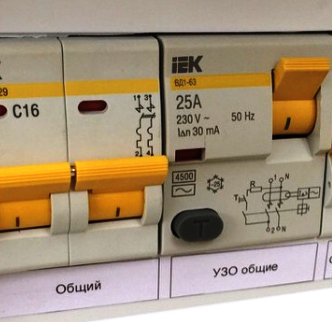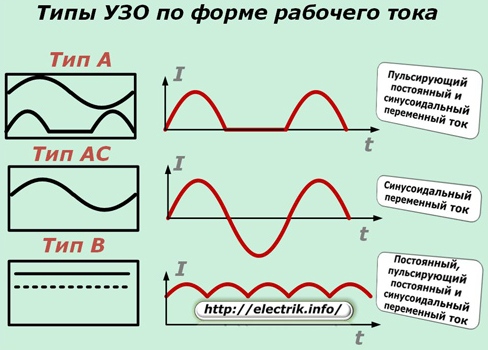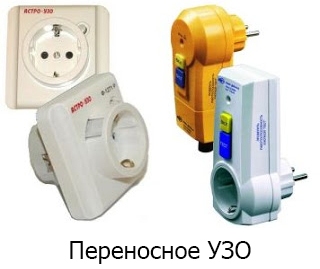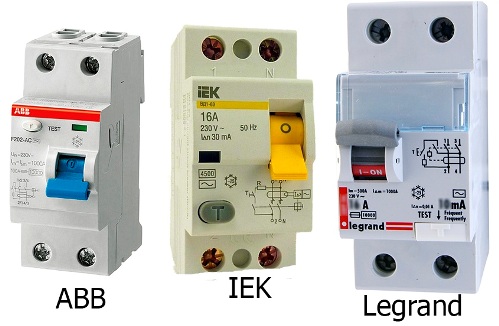Categories: Automata and RCD
Number of views: 18100
Comments on the article: 5
Which RCD to choose - criteria for the right choice
RCD is a residual current device. Such devices are designed to turn off the power supply. in case of current leakage. The latter can happen if you touch a bare wire, if a child accidentally puts something metallic into the socket, and also as a result of damage to the insulation of the wires.
In order to protect yourself and your home, you must correctly select the protective disconnect device. To begin with, we will figure out what types of protective devices are.

RCD trip principles
All RCDs are divided into two types according to the principle of operation: on electromechanical and electronic.
Electromechanical devices are independent of voltage, their source is a differential current (leakage current), which is formed in the fault line.
Electronic, on the contrary, depends on the mains voltage, and in order to disconnect a damaged circuit, the device needs an external source. For this reason, electronic RCDs are not very popular, despite the fact that their price is much lower than for electromechanical ones.
Types of RCD
There are three types of protective apparatus: AC, A, B. Each of these types is disconnected from a different type of current leakage, some disconnect alternating current, others both alternating and pulsating.
AC protective devices react only to alternating current. Examples of devices with this type of current: lighting, underfloor heating, small household appliances, etc. You can determine the RCD of this type by writing AC on the device panel or using a special icon.
Type A Protective Devices can respond to both alternating and pulsating currents. Examples of devices with pulsating current: large household appliances, computers, all devices that are electronically controlled. The designation of an RCD of this type is either two letters AC or a special icon.
Type B safety devices They are used exclusively in industry, so you should not consider them for home use.

Read more about the various types and types of RCDs here: What RCDs exist and what is their difference
Before proceeding with the purchase of an RCD, you need to find out its technical parameters. Choosing a residual current device is based on several criteria: voltage dependence (electronic or electromechanical), installation method, rated current, number of poles.

Rated current
Rated current is an indicator that affects the occurrence of a short circuit. This characteristic unit determines the reliability and strength of the device, the quality of its work.
The choice of RCDs with one or another rated current depends on the magnitude of the load. The rated current is selected from the standard range: 6, 16, 25, 40, 63, 80, 100, 125 amperes. The value of this technical indicator is determined by the cross section of the used conductors and their power contacts (these values are indicated on the front panel of the device).
Many specialists in electrical work recommend choosing a device with a rated current one step higher, because Such an indicator will ensure the reliability of the use of RCDs and increase its service life.
Example: you have a 40A machine; choosing a protective device costs 63A.
Number of poles
For a three-phase network, an RCD with four poles is required. Such a device provides protection for a single-phase network or for individual devices that have a three-phase network. Be sure to install a four-pole circuit breaker in combination with such an RCD.
For a single-phase network, bipolar devices are installed.
Installation method
All RCDs are divided into two types according to installation methods. The first category of devices is stationary, the second is portable.Stationary are large, designed for all devices in the room and are installed in a specially designated shield. Read more about the correct installation and connection of RCDs here: Schemes of connection of UZO and bifa machines.
Unlike stationary devices, portable devices have a small size (slightly larger than an outlet), much cheaper, are installed within the premises and are designed to protect an individual device.

Manufacturers Overview
Below we provide a list of well-known domestic and foreign manufacturers, which, according to electricians, are the most durable and reliable.
-
ABB - Swedish-Swiss company, which occupies a leading position in the market of electrical appliances. According to the specialists of the RCD of this manufacturer, the highest quality and safest. You will have to pay for such products more than for domestic.
-
Legrand - A French company that is not inferior to ABB. The products of this company are also of high quality and a considerable price. If you choose between ABB and Legrand, then there is no difference.
-
Schneider electric - A French company that has taken a leading position in the Russian market and is popular with many electricians.
-
Siemens - The company specializes in the manufacture of appliances for domestic use. The quality is slightly lower than that of the above competitors, but still the devices of this manufacturer are also very popular.
-
Moeller - German-made RCDs that meet all quality standards and are also popular in Russia.
-
IEK - devices of the Russian manufacturer at a low price.
-
Contactor - one of the best domestic firms. The plant is owned by the French company Legrand, which means that the production uses the same high-quality materials as the well-known brand. The price of such an RCD is about the same as that of Legrand.
-
Dekraft - A Russian company that has recently entered the market. Low cost justifies low quality, while such devices are often used in the construction of industrial facilities.

Recommendations to consider when installing and connecting an RCD:
-
it is worth remembering that a grounding conductor is not needed in connecting the device;
-
RCD power supply is connected only to the upper terminals;
-
the power neutral is connected to the connector marked with the symbol "N";
-
the largest value of the possible current should be equal to or greater than the value of the current of atoms;
-
After installation, be sure to check the operation of the residual current device.
The final choice of an RCD will depend on how many household appliances you have installed. So, for residential premises, it is recommended to use RCDs of type A. It is also recommended to install protective devices in group networks, RCDs must ensure reliable operation of the load circuit, taking into account overloads.
Choose a foreign or domestic manufacturer, it's up to you. Domestic is much cheaper, but do not forget that the RCD is responsible for the safety of your home. Well, in order not to make a mistake with the choice and be sure of protection, it is better to entrust the choice of the device to an experienced specialist.
Alexander Moroshkin
See also at i.electricianexp.com
:
